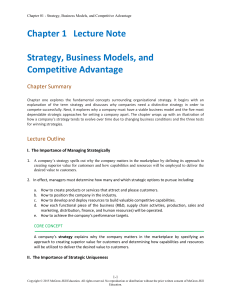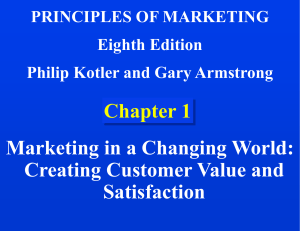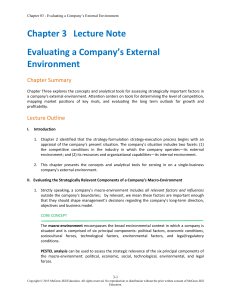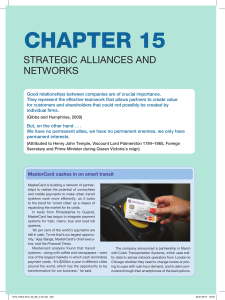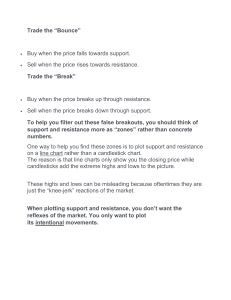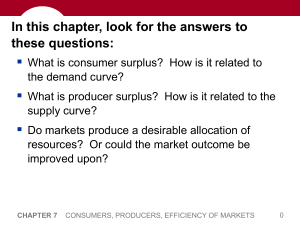Uploaded by
common.user24048
Crafting & Executing Strategy: Competitive Advantage Guide
advertisement
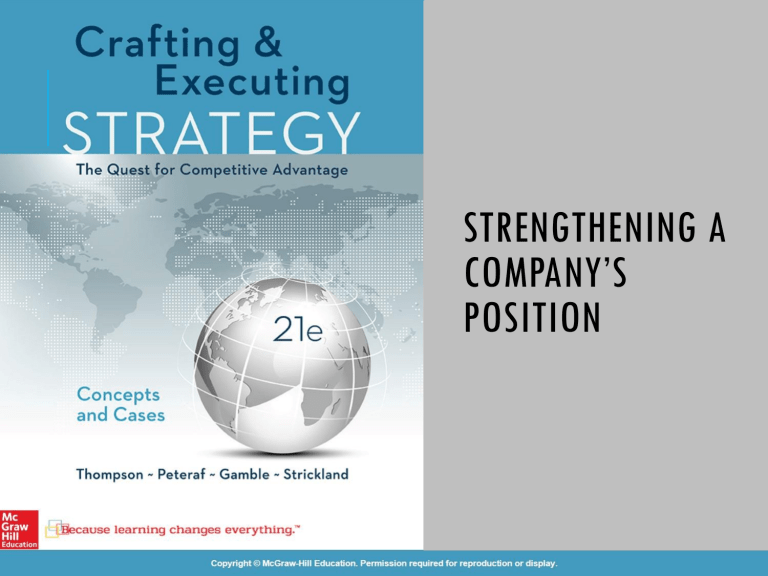
STRENGTHENING A COMPANY’S POSITION MAXIMIZING THE POWER OF A STRATEGY Making choices that complement a competitive approach and • maximize the power of strategy • • Offensive and defensive competitive actions • Competitive dynamics and the timing of strategic moves Scope of operations along the industry’s value chain • CONSIDERING STRATEGY-ENHANCING MEASURES 1. Whether and when to go on the offensive strategically 2. Whether and when to employ defensive strategies 3. When to undertake strategic moves—first mover, a fast follower, or a late mover 4. Whether to merge with or acquire another firm 5. Whether to integrate backward or forward into more stages of the industry’s activity chain 6. Which value chain activities, if any, should be outsourced 7. Whether to enter into strategic alliances or partnership arrangements LAUNCHING STRATEGIC OFFENSIVES TO IMPROVE A COMPANY’S MARKET POSITION Strategic offensive principles 1. Focusing relentlessly on building competitive advantage and then striving to convert it into sustainable advantage 2. Applying resources where rivals are least able to defend themselves 3. Employing the element of surprise as opposed to doing what rivals expect and are prepared for 4. Displaying a capacity for swift, decisive, and overwhelming actions to overpower rivals CHOOSING THE BASIS FOR COMPETITIVE ATTACK Avoid directly challenging a targeted competitor where it is strongest. Use the firm’s strongest strategic assets to attack a competitor’s weaknesses. The offensive may not yield immediate results if market rivals are strong competitors. Be prepared for the threatened competitor’s counterresponse. PRINCIPAL OFFENSIVE STRATEGY OPTIONS 1. Offering an equally good or better product at a lower price 2. Leapfrogging competitors by being first to market with nextgeneration products 3. Pursuing continuous product innovation to draw sales and market share away from less innovative rivals 4. Pursuing disruptive product innovations to create new markets PRINCIPAL OFFENSIVE STRATEGY OPTIONS 5. Adopting and improving on the good ideas of other companies (rivals or otherwise) 6. Using hit-and-run or guerrilla marketing tactics to grab market share from complacent or distracted rivals 7. Launching a preemptive strike to secure an industry’s limited resources or capture a rare opportunity CHOOSING WHICH RIVALS TO ATTACK Best Targets for Offensive Attacks Market leaders that are in vulnerable competitive positions Runner-up firms with weaknesses in areas where the challenger is strong Struggling enterprises on the verge of going under Small local and regional firms with limited capabilities BLUE OCEAN STRATEGY https://www.youtube.com/watch?v=7SQDGBSjty4 DEFENSIVE STRATEGIES—PROTECTING MARKET POSITION AND COMPETITIVE ADVANTAGE Purposes of Defensive Strategies Lower the firm’s risk of being attacked Weaken the impact of an attack that does occur Influence challengers to aim their efforts at other rivals FORMS OF DEFENSIVE STRATEGIES Defensive strategies can take either of two forms Actions to block challengers Actions to signal the likelihood of strong retaliation BLOCKING THE AVENUES OPEN TO CHALLENGERS 1. Introduce new features and models to broaden product lines to close off gaps and vacant niches. 2. Maintain economy-pricing to thwart lower price attacks. 3. Discourage buyers from trying competitors’ brands. 4. Make early announcements about new products or price changes to induce buyers to postpone switching. 5. Offer support and special inducements to current customers to reduce the attractiveness of switching. 6. Challenge quality and safety of competitor’s products. 7. Grant discounts or better terms to intermediaries who handle the firm’s product line exclusively. SIGNALING CHALLENGERS THAT RETALIATION IS LIKELY Signaling is an effective defensive strategy when the firm follows through by: Publicly announcing its commitment to maintaining the firm’s present market share Publicly committing to a policy of matching competitors’ terms or prices Maintaining a war chest of cash and marketable securities Making a strong counter-response to the moves of weaker rivals to enhance its tough defender image TIMING A FIRM’S OFFENSIVE AND DEFENSIVE STRATEGIC MOVES Timing’s importance: Knowing when to make a strategic move is as crucial as knowing what move to make. Moving first is no guarantee of success or competitive advantage. The risks of moving first to stake out a monopoly position versus being a fast follower or even a late mover must be carefully weighed. CONDITIONS THAT LEAD TO FIRST-MOVER ADVANTAGES 1. When pioneering helps build a firm’s reputation and creates strong brand loyalty 2. When a first mover’s customers will thereafter face significant switching costs 3. When property rights protections thwart rapid imitation of the initial move 4. When an early lead enables movement down the learning curve ahead of rivals 5. When a first mover can set the technical standard for the industry THE POTENTIAL FOR LATE-MOVER ADVANTAGES OR FIRST-MOVER DISADVANTAGES 1. When pioneering is more costly than imitating and offers negligible experience or learning-curve benefits 2. When the products of an innovator are somewhat primitive and do not live up to buyer expectations 3. When rapid market evolution allows fast followers to leapfrog a first mover’s products with more attractive next-version products 4. When market uncertainties make it difficult to ascertain what will eventually succeed 5. When customer loyalty is low and first mover’s skills, know-how, and actions are easily copied or surpassed TO BE A FIRST MOVER OR NOT Does market takeoff depend on complementary products or services that currently are not available? Is new infrastructure required before buyer demand can surge? Will buyers need to learn new skills or adopt new behaviors? Will buyers encounter high switching costs in moving to the newly introduced product or service? Are there influential competitors in a position to delay or derail the efforts of a first mover? STRENGTHENING A FIRM’S MARKET POSITION VIA ITS SCOPE OF OPERATIONS Defining the Scope of the Firm’s Operations Range of its activities performed internally Breadth of its product and service offerings Extent of its geographic market presence and its mix of businesses Size of its competitive footprint on its market or industry HORIZONTAL VS. VERTICAL SCOPE Horizontal scope the range of product and service segments that a firm serves within its focal market. Vertical scope the extent to which a firm’s internal activities encompass one, some, many, or all of the activities that make up an industry’s entire value chain system, ranging from raw-material production to final sales and service activities. MERGER AND ACQUISITION STRATEGIC OJECTIVES FOR HORIZONTAL MERGERS AND ACQUISITIONS Creating a more cost-efficient operation out of the combined companies Expanding the firm’s geographic coverage Extending the firm’s business into new product categories Gaining quick access to new technologies or other resources and capabilities Leading the convergence of industries whose boundaries are being blurred by changing technologies and new market opportunities BENEFITS OF INCREASING HORIZONTAL SCOPE Increasing a firm’s horizontal scope strengthens its business and increases its profitability by: Improving the efficiency of its operations Heightening its product differentiation Reducing market rivalry Increasing the firm’s bargaining power over suppliers and buyers Enhancing its flexibility and dynamic capabilities HINDALCO ACQUISITIONS WHY MERGERS AND ACQUISITIONS SOMETIMES FAIL TO PRODUCE ANTICIPATED RESULTS Strategic issues Cost savings may prove smaller than expected. Gains in competitive capabilities take longer to realize or never materialize at all. Organizational issues Cultures, operating systems and management styles fail to mesh due to resistance to change from organization members. Key employees at the acquired firm are lost. Managers overseeing integration make mistakes in melding the acquired firm into their own. https://www.youtube.com/watch?v=9dFvhq2sKfM TYPES OF VERTICAL INTEGRATION STRATEGIES Full integration A firm participates in all stages of the vertical activity chain. Example: Departemen Dalam Negeri IPDN Partial integration A firm builds positions only in selected stages of the vertical chain. Example: Stikes Borromeus RS Borromeus Disney DisneyChannel Tapered integration A firm uses a mix of in-house and outsourced activity in any stage of the vertical chain. Example: Toyota and its suppliers THE ADVANTAGES OF A VERTICAL INTEGRATION STRATEGY Benefits of a Vertical Integration Strategy Add materially to a firm’s technological capabilities Strengthen the firm’s competitive position Boost the firm’s profitability INTEGRATING BACKWARD TO ACHIEVE GREATER COMPETITIVENESS Integrating backwards by: Achieving same scale economies as outside suppliers: low-cost based competitive advantage Matching or beating suppliers’ production efficiency with no dropoff in quality: differentiation-based competitive advantage Reasons for integrating backwards Reduction of supplier power Reduction in costs of major inputs Assurance of the supply and flow of critical inputs Protection of proprietary know-how INTEGRATING FORWARD TO ENHANCE COMPETITIVENESS Reasons for integrating forward To lower overall costs by increasing channel activity efficiencies relative to competitors To increase bargaining power through control of channel activities To gain better access to end users To strengthen and reinforce brand awareness To increase product differentiation DISADVANTAGES OF A VERTICAL INTEGRATION STRATEGY Increased business risk due to large capital investment Slow acceptance of technological advances or more efficient production methods Less flexibility in accommodating shifting buyer preferences that require non-internally produced parts Internal production levels may not reach volumes that create economies of scale Efficient production of internally-produced components and parts hampered by capacity matching problems New or different resources and capabilities requirements OUTSOURCING involves contracting out certain value chain activities that are normally performed in-house to outside vendors. Outsource an activity if it: Can be performed better or more cheaply by outside specialists Is not crucial to achieving sustainable competitive advantage Improves organizational flexibility and speeds time to market Reduces risk exposure due to new technology or buyer preferences Allows the firm to concentrate on its core business, leverage key resources, and do even better what it already does best Why outsource Why outsorcing is bad for business STRATEGIC ALLIANCE AND JOINT VENTURE A strategic alliance is a formal agreement between two or more separate companies in which they agree to work cooperatively toward some common objective. A joint venture is a partnership involving the establishment of an independent corporate entity that the partners own and control jointly, sharing in its revenues and expenses. WHY AND HOW STRATEGIC ALLIANCES ARE ADVANTAGEOUS Strategic Alliances: Expedite development of promising new technologies or products Help overcome deficits in technical and manufacturing expertise Bring together the personnel and expertise needed to create new skill sets and capabilities Improve supply chain efficiency Help partners allocate venture risk sharing Allow firms to gain economies of scale Provide new market access for partners CAPTURING THE BENEFITS OF STRATEGIC ALLIANCES Being sensitive to cultural differences Recognizing that the alliance must benefit both sides Picking a good partner Strategic Alliance Factors Ensuring both parties keep their commitments Structuring the decision-making process for swift actions Adjusting the agreement over time to fit new circumstances Jump to Appendix 6 long image description REASONS FOR ENTERING INTO STRATEGIC ALLIANCES When seeking global market leadership Enter into critical country markets quickly. Gain inside knowledge about unfamiliar markets and cultures through alliances with local partners. Provide access to valuable skills and competencies concentrated in particular geographic locations. When staking out a strong industry position Establish a stronger beachhead in target industry. Master new technologies and build expertise and competencies. Open up broader opportunities in the target industry. ACHIEVING LONG-LASTING STRATEGIC ALLIANCE RELATIONSHIPS Factors Influencing the Longevity of Alliances Collaborating with partners that do not compete directly Establishing a permanent trusting relationship Continuing to collaborate is in the parties’ mutual interest THE DRAWBACKS OF STRATEGIC ALLIANCES AND PARTNERSHIPS • Culture clash and integration problems due to different management styles and business practices • Anticipated gains not materializing due to an overly optimistic view of the potential for synergies or the unforeseen poor fit of partners’ resources and capabilities • Risk of becoming dependent on partner firms for essential expertise and capabilities • Protection of proprietary technologies, knowledge bases, or trade secrets from partners who are rivals
